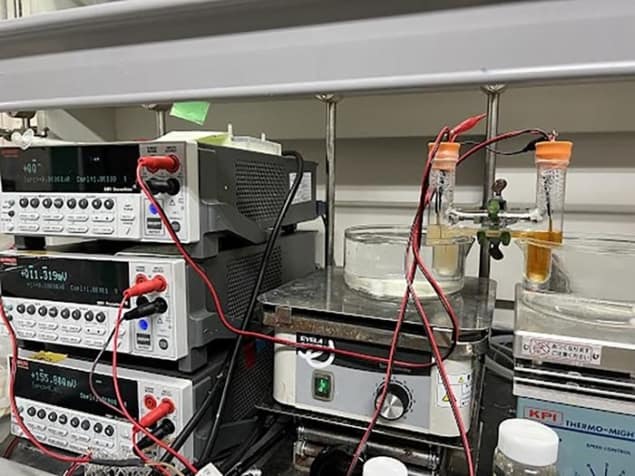
A new “thermocell” that generates a voltage by exploiting temperature-related phase transitions in a pair of electrodes has been unveiled by researchers in Japan. Teppei Yamada at the University of Tokyo and colleagues hope that their new technology could lead to the development of new ways of recycling waste heat.
When a temperature difference arises across the junction between two different conductive materials, a voltage is created via the thermoelectric effect. Today, this phenomenon is being explored for its potential to harvest energy from natural temperature gradients, and for recycling waste heat from vehicles, power plants, and computer processors.
In their research, Yamada’s team explored the thermoelectric effect using thermocells. These are devices that exploit the effect using reduction–oxidation (redox) reactions, whereby one species of atoms or molecules either gains or loses electrons to another species.
“Thermocells are thermoelectric conversion systems consisting of a solution of molecules which exhibit a redox reaction; they create electrical energy by taking advantage of the shift in the equilibrium of the redox reaction in response to temperature,” Yamada explains.
Triggered reactions
If a temperature difference occurs between the thermocell’s electrodes, it can trigger an oxidation reaction in one electrode, and a reduction reaction in the other – generating a voltage between them.
In their previous research, Yamada and colleagues have investigated how different chemical and physical changes to the thermocell’s electrodes can improve their efficiency. This is measured by their Seebeck coefficient – which relates the magnitude of the thermocell’s voltage to the temperature difference between its electrodes.
In their latest study, the researchers unveil their most efficient design yet – which is based around a hydrogel made from PMIPAM polymer. “We focused on the ‘coil-globule transition’ of these polymers,” Yamada explains. “This property causes the polymer chains to stretch and separate at low temperatures, but to become spherical and coalesce when the temperature is raised.”
This transformation is a distinct phase transition: in their stretched, coiled form, oxidized PMIPAM molecules are hydrophilic, drawing water molecules towards them. When they transform into reduced globules, they become hydrophobic – releasing their surrounding water molecules.
Promising opportunity
For Yamada’s team, this temperature-induced phase transition presents a promising opportunity to generate electricity from latent heat. This is the energy absorbed or released by molecules as they undergo a transition from one phase to the other.
Even when the energy difference between both phases was very small, the thermocell could generate an impressively high voltage between two electrodes containing oxidized and reduced molecules. “As expected, we obtained a large Seebeck coefficient in the temperate region where the coil-globule transition occurs,” Yamada says.

Thermophotovoltaic cells top 40 per cent efficiency
The teams also demonstrated the reverse process: generating a temperature difference between two electrodes by applying a current.
The researchers hope their result could pave the way for a new generation of high-performing thermocells powered by the latent heat of phase transitions. Yet as Yamada explains, there is still much room for improvement. “There are many other materials that exhibit phase transitions,” he says. “As long as we can give them redox activity, they could be used in thermocells.”
With future improvements, electrochemical thermocells could drastically improve our ability to recycle waste heat. This would be particularly useful in air conditioning and refrigeration – where strong temperature gradients emerge between spaces being cooled, and areas where waste heat is ejected.
Converting some of this waste energy back into electricity could help to slash the overall energy consumption of these cooling systems, and by extension, their sizeable carbon footprint.
The research is described in Advanced Materials.
